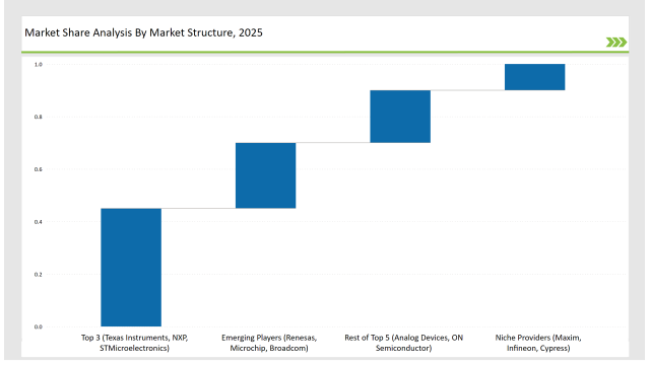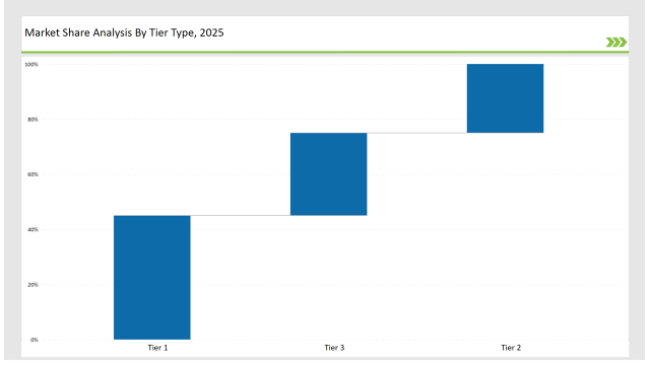The I2C (Inter-Integrated Circuit) bus market is witnessing impressive growth as the industries are inclined towards the adoption of efficient, low power communication protocols for embedded systems, consumer electronics, and automotive applications. Texas Instruments, NXP Semiconductors, and STMicroelectronics, the leading three I2C bus manufacturers, account for 45% of market share and offer high-performance I2C bus solution, low-power communication interface, and circuits integration board.
While the remaining top five, which includes Analog Devices and ON Semiconductor, account for 20%, focused on signal integrity, high speed data transmission and compatibility across different applications. 25% share is held by emerging players like Renesas Electronics, Microchip Technology, Broadcom, which specialize in faster data transfers, bidirectional communication and end-to-end real-time monitoring solutions. 10% is filled by niche providers like Maxim Integrated, Infineon Technologies, and Cypress Semiconductor, solving for industrial automation, IoT, and security use case.
Explore FMI!
Book a free demo
| Category | Industry Share (%) |
|---|---|
| Top 3 (Texas Instruments, NXP, STMicroelectronics) | 45% |
| Rest of Top 5 (Analog Devices, ON Semiconductor) | 20% |
| Emerging Players (Renesas, Microchip, Broadcom) | 25% |
| Niche Providers (Maxim, Infineon, Cypress) | 10% |

The market is moderately consolidated, where top players control 45-65% of the market. Companies like Texas Instruments and NXP Semiconductors dominate, but mid-sized vendors continue to innovate for IoT and automotive applications.
AI-Powered Communication Optimization
To enhance real-time data flow: High-performance chips today need to transmit data at greater rates while also consuming less power which is brought by high integration and innovation.
Blockchain-Based Data Authentication
Blockchain is also integrated with I2C communication modules to guarantee data integrity, which is a significant factor in critical areas like automotive and healthcare.
Cloud-Based Monitoring Solutions
Cloud-integrated I2C bus analytics tools are being employed by organizations to keep track of device interactions and identify anomalies in real time.
Security & Encryption Enhancements
Data Leakage and cyber threats are common in industrial applications and consumer products due to which new encryption standards are integrated with I2C communication.
Legal & Compliance Integration
Vendors are adapting their I2C solutions to meet global standards like ISO 26262 for automotive use and IEC 60601 for medical equipment.

| Tier | Tier 1 |
|---|---|
| Vendors | Texas Instruments, NXP, STMicroelectronics |
| Consolidated Market Share (%) | 45% |
| Tier | Tier 2 |
|---|---|
| Vendors | Analog Devices, ON Semiconductor, Renesas |
| Consolidated Market Share (%) | 25% |
| Tier | Tier 3 |
|---|---|
| Vendors | Microchip, Broadcom, Infineon, Maxim Integrated |
| Consolidated Market Share (%) | 30% |
| Vendor | Key Focus |
|---|---|
| Texas Instruments | Low-power I2C solutions for battery-operated devices |
| NXP Semiconductors | Automotive-grade I2C interfaces with EMI protection |
| STMicroelectronics | AI-powered, high-speed I2C communication modules |
| Analog Devices | Secure I2C communication with built-in encryption |
| ON Semiconductor | Space-efficient, high-performance I2C transceivers |
| Renesas | IoT-ready I2C bus solutions with cloud integration |
| Microchip Technology | Robust, real-time I2C monitoring tools |
Vendors are focused on AI-driven signal integrity improvements, security enhancements and ultra-fast I2C protocols for next-generation applications. The shift towards cloud-based monitoring and automated data authentication will redefine market dynamics while emerging regions present high-growth potential for expanded adoption.
Leading vendors Texas Instruments, NXP, and STMicroelectronics hold 45% of the market.
Emerging players such as Renesas, Microchip, and Broadcom account for 25%.
Market concentration is categorized as medium, with top 10 players controlling 60-70% of the market.
Electric Switches Market Insights – Growth & Forecast 2025 to 2035
Electrical Bushings Market Trends – Growth & Forecast 2025 to 2035
Edge Server Market Trends – Growth & Forecast 2025 to 2035
Eddy Current Testing Market Growth – Size, Demand & Forecast 2025 to 2035
3D Motion Capture Market by System, Component, Application & Region Forecast till 2035
IP PBX Market Analysis by Type and Region through 2035

Thank you!
You will receive an email from our Business Development Manager. Please be sure to check your SPAM/JUNK folder too.